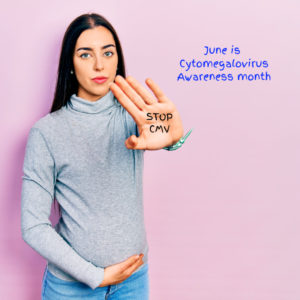17 Jun Did you know that Cytomegalovirus (CMV) is the most common infectious cause of disabilities in newborn babies

Did you know that Cytomegalovirus (CMV) ![]() is the most common infectious cause of disabilities in newborn babies
is the most common infectious cause of disabilities in newborn babies ![]()
![]() Did you know that there are simple steps you can take to reduce the risk of CMV transmission to your unborn baby
Did you know that there are simple steps you can take to reduce the risk of CMV transmission to your unborn baby ![]()
Cytomegalovirus (CMV) is a common virus in the herpesvirus family. ![]() Humans are the only source of CMV. The virus is found in urine, saliva, nasal mucous, breast milk, vaginal secretions and semen of infected people.
Humans are the only source of CMV. The virus is found in urine, saliva, nasal mucous, breast milk, vaginal secretions and semen of infected people.![]()
If a woman is newly infected with CMV while ![]() pregnant, there is a risk that her unborn baby
pregnant, there is a risk that her unborn baby ![]() will also become infected (congenital CMV). Infected babies may, but not always, be born with a disability. The highest risk to the unborn baby occurs when a woman who has never had CMV before is infected with the virus for the first time during the first half of the pregnancy.
will also become infected (congenital CMV). Infected babies may, but not always, be born with a disability. The highest risk to the unborn baby occurs when a woman who has never had CMV before is infected with the virus for the first time during the first half of the pregnancy. ![]()
![]() Studies in Australia have shown that about 1 in 1,000 live births, will have permanent disabilities of varying degree from a congenital CMV infection. These can include hearing loss, vision loss, small head size, cerebral palsy, developmental delay or intellectual disability, and in rare cases, death.
Studies in Australia have shown that about 1 in 1,000 live births, will have permanent disabilities of varying degree from a congenital CMV infection. These can include hearing loss, vision loss, small head size, cerebral palsy, developmental delay or intellectual disability, and in rare cases, death. ![]()
Pregnant women ![]() are recommended to take steps to reduce their risk of exposure to CMV and so reduce the risk of their developing baby becoming infected.
are recommended to take steps to reduce their risk of exposure to CMV and so reduce the risk of their developing baby becoming infected.
Wash hands often with soap![]() and running water for at least 15 seconds and dry them thoroughly. This should be done especially after close contact with young children, changing nappies, blowing noses, feeding a young child, and handling children’s toys, dummies/soothers.
and running water for at least 15 seconds and dry them thoroughly. This should be done especially after close contact with young children, changing nappies, blowing noses, feeding a young child, and handling children’s toys, dummies/soothers.
![]() Do not share food, drinks, eating utensils or toothbrushes with young children.
Do not share food, drinks, eating utensils or toothbrushes with young children.![]()
Avoid contact with saliva when kissing a child.![]()
Use simple detergent and water to clean toys, countertops and other surfaces that come into contact with children’s urine, mucous or saliva.
![]() Child care workers who are pregnant or considering pregnancy should pay particular attention to good hand hygiene, especially after changing nappies or assisting with blowing noses or toileting.
Child care workers who are pregnant or considering pregnancy should pay particular attention to good hand hygiene, especially after changing nappies or assisting with blowing noses or toileting.![]()
Together we can stop CMV. For more information go to www.cmv.org.au
